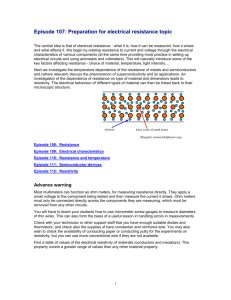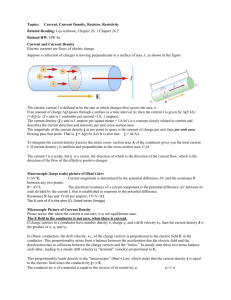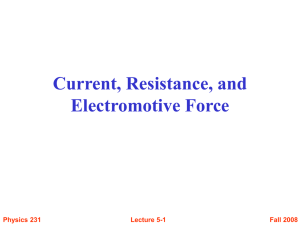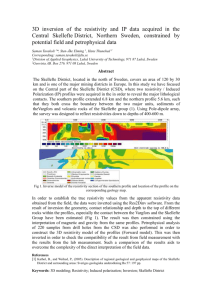Physics 2102 Spring 2002 Lecture 8
advertisement
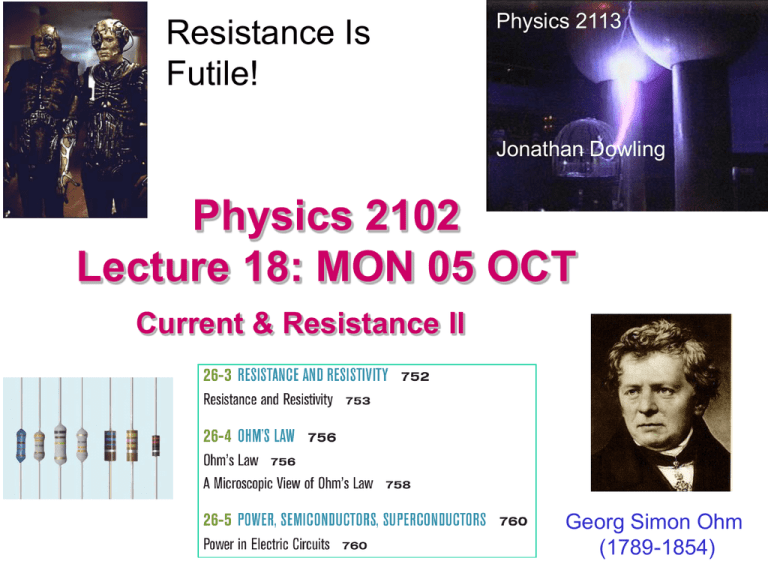
Resistance Is Futile! Physics 2113 Jonathan Dowling Physics 2102 Lecture 18: MON 05 OCT Current & Resistance II Georg Simon Ohm (1789-1854) Resistance is NOT Futile! Electrons are not “completely free to move” in a conductor. They move erratically, colliding with the nuclei all the time: this is what we call “resistance”. The mechanical analog is FRICTION. The resistance is related to the potential we need to apply to a device to drive a given current through it. The larger the resistance, the larger the potential we need to drive the same current. Ohm’s laws V Rº i Units : [R] = V and therefore : i = and V = iR R Volt º Ohm (abbr. W) Ampere Georg Simon Ohm (1789-1854) "a professor who preaches such heresies is unworthy to teach science.” Prussian minister of education 1830 Devices specifically designed to have a constant value of R are called resistors, and symbolized by dq éCù iº = ê ú º [ Ampere] = [ A] ësû dt Resistivity ρ vs. Resistance R Metal “field lines” These two devices could have the same resistance R, when measured on the outgoing metal leads. However, it is obvious that inside of them different things go on. resistivity: Resistivity is associated ( resistance: R=V/I ) r º [Wm] = [Ohm× meter] with a material, resistance with respect to a device 1 Conductivity : s = constructed with the material. r Example: A - L V + V E= , L i J= A r= Makes sense! For a given material: V L=RA i L A L R=r A Longer ® More resistance Wider ® Less resistance Fluid Flow: An Analogy for the PETEs! • Amount of Water = Charge • Pressure = Potential = Voltage • Flow Rate = Current = Amps The pressure at the end of the hose represents voltage. The amount of water in the tank represents charge. The rate of flow gallons/minute out the hose represents current or amperage. https://learn.sparkfun.com/tutorials/voltage-current-resistance-and-ohms-law Fluid Flow: An Analogy for the PETEs! R=r • Amount of Water = Charge • Pressure = Voltage • Flow Rate = Current = Amps Decrease hose width, decrease A, increase resistance R. Increase hose length L, increase resistance R. Put pebbles in the hose, increase resistivity ρ, increase resistance R. https://learn.sparkfun.com/tutorials/voltage-current-resistance-and-ohms-law L A 26.4: Resistance and Resistivity: The resistivity ρ of a resistor is defined as: The SI unit for is .m. The conductivity of a material is the reciprocal of its resistivity: Put pebbles or a filter in the hose, increase resistivity ρ, increase resistance R. 26.4: Resistance and Resistivity, Calculating Resistance from Resistivity: Think pumping water through a long hose. It is easier if L is short and A is big (small R). It is harder if L is long or A is small (big R). If the streamlines representing the current density are uniform throughout the wire, the electric field E and the current density J will be constant for all points within the wire. ICPP The copper wire has radius r. What happens to the Resistance R if you: (a) Double the Length? R ® 2R (b) Double the Area? R ® R / 2 (c) Double the Radius? R ® R / 4 A = pr2 What happens to the Resistivity ρ if you: (a)Double the Length? r®r (b)Double the Area? (c)Double the Radius?r ® r r®r Step I: The resistivity ρ is the same (all three are copper). Find the Resistance R=ρL/A for each case: Ra = rL A Rb = r ( 3L / 2 ) ( A / 2) =3 rL A Rc = r ( L / 2) ( A / 2) Rb > Ra = Rc Step II: Rank the current using V=iR or i=V/R with V constant! ia = ic > ib Ranking is reversed since R is downstairs. = rL A Example Two conductors are made of the same material and have the same length. Conductor A is a solid wire of diameter r=1.0mm. Conductor B is a hollow tube of outside diameter 2r=2.0mm and inside diameter r=1.0mm. What is the resistance ratio RA/RB, measured between their ends? A R= L/A B AA= r2 AB= (2r)2 - r2 =3r2 RA/RB= AB/AA= 3 LA=LB=L Cancels Example, A material has resistivity, a block of the material has a resistance.: 26.4: Resistance and Resistivity, Variation with Temperature: The relation between temperature and resistivity for copper—and for metals in general— is fairly linear over a rather broad temperature range. For such linear relations we can write an empirical approximation that is good enough for most engineering purposes: Resistivity and Temperature Resistivity depends on temperature: = 0(1+ (T–T0) ) • At what temperature would the resistance of a copper conductor be double its resistance at 20.0°C? • Does this same "doubling temperature" hold for all copper conductors, regardless of shape or size? Resistance is NOT Futile! Electrons are not “completely free to move” in a conductor. They move erratically, colliding with the nuclei all the time: this is what we call “resistance”. The mechanical analog is FRICTION. The resistance is related to the potential we need to apply to a device to drive a given current through it. The larger the resistance, the larger the potential we need to drive the same current. Ohm’s laws V Rº i Units : [R] = V and therefore : i = and V = iR R Volt º Ohm (abbr. W) Ampere Georg Simon Ohm (1789-1854) "a professor who preaches such heresies is unworthy to teach science.” Prussian minister of education 1830 Devices specifically designed to have a constant value of R are called resistors, and symbolized by dq éCù iº = ê ú º [ Ampere] = [ A] ësû dt 26.5: Ohm’s Law: L A=r2 A Current Density: J=i/A Units: [A/m2] Resistance: R= L/A Resitivity: depends only on Material and Temperature. Units: [•m] V = iR R = V / i = constant Example An electrical cable consists of 105 strands of fine wire, each having r=2.35 resistance. The same potential difference is applied between the ends of all the strands and results in a total current of 0.720 A. (a) What is the current in each strand? i=I/105=0.720A/105=[0.00686] A (b) What is the applied potential difference? V=ir=[0.016121] V (c) What is the resistance of the cable? R=V/I=[.0224 ] Rd = 1.0x105 im = 1x10–3A Rw = 1.5x103 im = V1 = imRd i1 = V1/Rw V2 = imRw Example A human being can be electrocuted if a current as small as i=100 mA passes near the heart. An electrician working with sweaty hands makes good contact with the two conductors he is holding. If his resistance is R=1500, what might the fatal voltage be? (Ans: 150 V) Use: V=iR b Power in electrical circuits A battery “pumps” charges through the resistor (or any device), by producing a potential difference V between points a and b. How much work does the battery do to move a small amount of charge dq from b to a? a V Rº i V and therefore : i = R Ohm’s laws and V = iR dW = –dU = -dq×V = (dq/dt)×dt×V= iV×dt The battery “power” is the work it does per unit time: P = dW/dt = iV P=iV is true for the battery pumping charges through any device. If the device follows Ohm’s law (i.e., it is a resistor), then V=iR or i=V/R and P = iV = i2R = V2/R Ohm’s Law and Power in Resistors Watt? You Looking At! éV ù Units : R = ê ú º [W] = [Ohm] ë Aû Ohm’s Law V = iR Power Dissipated by a Resistor: P = iV = i R = V /R 2 2 [ s ] = [W] = [Watt] Units : P = J Example, Rate of Energy Dissipation in a Wire Carrying Current: ICPP: Why is this unwise??? P = iV ® 4P = (4i)V Current i increases by 4. House Circuit Breaker 3A. P = iV = i R = V / R 2 2 i = P / V = 200W /120V = 1.67A ® 4P / V = 6.67A P = iV =i R 2 =V /R 2 Pa = Pb > Pd > Pc ( ( ) ( ) (a) P = V / R ® ( 2V ) / R = 4 V / R = 4P 2 2 (b) P = i R ® ( 2i ) R = 4 i 2 R = 4P 2 2 2 1 (c) P = V / R ® V / ( 2R ) = 2 V / R = 12 P 2 2 2 (d) P = i R ® i ( 2R ) = 2 ( i R ) = 2P 2 2 2 ) ICPP: The figure here shows three cylindrical copper conductors along with their face areas and lengths. Rank them according to the power dissipated by them, greatest first, when the same potential difference V is placed across their lengths. P = iV = i R = V / R 2 2 Step I: The resistivity ρ is the same (all three are copper). Find the Resistance R=ρL/A for each case: Ra = rL A Rb = r 3L / 2 A/2 =3 rL A = 3Ra Rc = rL / 2 A/2 Ra = Rc < Rb Step II: Rank the power using P=V2/R since V is same. Pa = Pc > Pb Ranking is reversed since R is downstairs. = rL A = Ra Example A P=1250 Watt radiant heater is constructed to operate at V=115Volts. (a) What will be the current in the heater? (b) What is the resistance of the heating coil? (c) How much thermal energy is produced in 1.0 hr by the heater? • Formulas: P=i2R=V2/R; V=iR • Know P, V; need R to calculate current! • P=1250W; V=115V => R=V2/P=(115V)2/1250W=10.6 • i=V/R= 115V/10.6 =10.8 A • Energy? P=dU/dt => U=P×t = 1250W × 3600 sec= 4.5 MJ = 1.250kW•hr Example A 100 W lightbulb is plugged into a standard 120 V outlet. (a) What is the resistance of the bulb? (b) What is the current in the bulb? (c) How much does it cost per month to leave the light turned on continuously? Assume electric energy costs 6¢/kW·h. (d) Is the resistance different when the bulb is turned off? • Resistance: same as before, R=V2/P=144Ω • Current, same as before, i=V/R=0.83 A • We pay for energy used (kW h): U=Pt=0.1kW × (30× 24) h = 72 kW h => $4.32 • (d): Resistance should be the same, but it’s not: resistivity and resistance increase with temperature. When the bulb is turned off, it is colder than when it is turned on, so the resistance is lower. i V P = iV U = Pt t in seconds V i P = iV [J/s is Watt] P = iV [Watt is J/s] I’m switching to white light LEDs! Nobel Prize 2014! My House Has Two Front Porch Lights. Each Light Has a 100W Incandescent Bulb. The Lights Come on at Dusk and Go Off at Dawn. How Much Do these lights Cost Me Per Year? Two 100W Bulbs @ 12 Hours Each = One 100W @ 24 Hours. P = 100W = 0.1kW T = 365 Days x 24 Hours/Day = 8670 Hours Demco Rate: D = 0.1797$/(kW×Hour) (From My Bill!) Cost = PxTxD = (0.1kW)x(8670 Hours)x(0.1797$/kW×Hour) = $157.42 • Figure shows a person and a cow, each a radial distance D=60m from the point where lightning of current i=10kA strikes the ground. The current spreads through the ground uniformly over a hemisphere centered on the strike point. The person's feet are separated by radial distance Δrper=0.50m; the cow's front and rear hooves are separated by radial distance Δrcow=1.50m. The resistivity of the ground is ρgr=100 Ωm . The resistance both across the person, between left and right feet, and across the cow, between front and rear hooves, is R=4.00kΩ. (a) What is the current ip through the person? (b) What is the current ic through the cow? Recall that a current ≥ 100mA causes a heart attack and death. •

